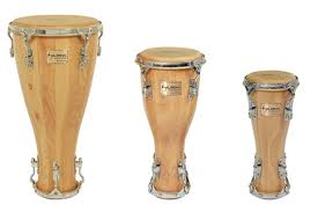Drumming and Dancing Rituals

The iya, the itotele, and the okonkolu
Drumming and dancing in Santería aren't just for entertainment. They're religious rituals performed to honor the Orichás and to entice them to interact with humans through trance possession. During a tambor (drumming ceremony) the sacred batá drums are played. These are three hourglass shaped drums, each with two heads. They rest across the player's lap in a horizontal position, and and played with both hands. These drums have been ceremoniously prepared and charged with the spirit of the drum, called Aña, and they're only used for religious purposes. They're considered holy objects because they communicate with the Orichás. Drummers must undergo intensive training and special ceremonies in order to have the right to play the drums. In traditional Santería communities, the drums are played only by men. The largest drum is called the iya, or mother drum. It's the leader, and calls for changes in rhythms and songs as the ceremony progresses. The middle sized drum is called the itotele, and it carries on a conversation with the iya drum, to create a complex rhythm. The smallest drum is the okonkolu, and this maintains the underlying beat of the syncopated rhythms. For those unfamiliar with African style drumming, the complexity of the rhythms can be astounding. They reproduce the tonal language of the Yoruba people, speaking to the Orichás in their native tongue. Generally, a singer known as the akpwon performs with the drummers. He or she acts as master of ceremonies and leads the call and response singing of the assembled worshippers.
